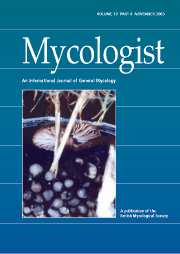Article contents
Teaching Techniques for Mycology: 22. Disclosure of Conidiobolus and Basidiobolus from soils and leaf litters
Published online by Cambridge University Press: 07 June 2004
Extract
Entomophthoralean fungi cause many of the epizootics in the world's arthropod populations. Most are obligate insect or mite pathogens and thus are not readily cultured (Pel et al, 2001). In contrast, almost all the common Conidiobolus and Basidiobolus species, widespread in litter and soils of the temperate regions, grow on simple media. Easily observed under the microscope, these necrotrophs or specialised saprotrophs of arthropods exemplify many aspects of entomophthoralean biology. They are strongly chitinolytic, proteolytic and lipolytic and they can colonise arthropod cadavers. The violent discharge of conidia so characteristic of entomophthoralean fungi is easily observed and studied in Conidiobolus spp. (Ingold, 1971). This ‘trick’ of shooting off conidia, presumably essential for contacting a passing animal as potential vector and eventual substrate, is also extraordinarily useful to a mycologist for experimentally manipulating these fungi. It allows escape from most other co-occurring microbiota, showering of experimental target arthropods (living and dead) and collection of successive generations of repetitional conidia (Waters & Callaghan, 1999). This last feature allows study of the intriguing alternatives to globose conidia. Such alternatives include, for a few species, capillioconidia able to adhere to nearby arthropods, (cf B. ranarum, Weber & Webster, 1998) and for some, actively discharged elongate conidia (ADEC). Most characteristically, in about 11 species, microconidia can form and discharge from the parent spore (Webster, 1980). These alternative conidial forms are easily missed and may form only from later generations of repetitional conidium development on non-nutritive agar media; particularly when water activity (aw) is slightly lowered by inclusion of sorbitol or glycerol (see Appendix).
Information
- Type
- Original Article
- Information
- Copyright
- © 2004 Cambridge University Press
- 3
- Cited by

